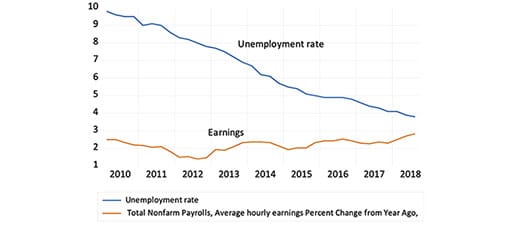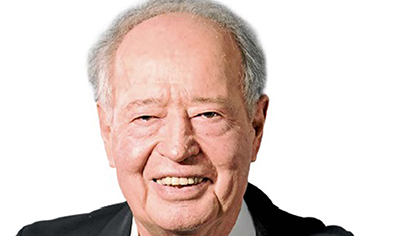The bond market indicates that inflation is expected to stay below 2% over the next 10 years in the US, while the Fed is confidently expected not to raise short term rates this year.
Are such views consistent with the current very buoyant labour market? Unemployment rates are below 4%, while average earnings are rising at about 3% a year. Some believe this portends more inflation and higher interest rates, which would confound the market consensus.
US unemployment rate and growth in earnings

Source: Fred – Federal Reserve Bank of St Louis and Investec Wealth & Investment
Do changes in prices lead or follow changes in wage rates in the US? The economic reality is that they both follow and lead, with variable lags. The markets for goods and the markets for labour have the general state of the economy in common. The wages and prices that emerge depend upon how rapidly the demand for and the supply of all goods, services and labour are growing. Higher or lower prices, wages and asset valuations have their causes and in turn will have effects on the willingness to buy or sell.
The markets for goods and the markets for labour have the general state of the economy in common.
Might not higher real wages in the US soon reduce the demand for labour and employment – as they have done in SA? The prices of goods and services are not simply determined by adding a constant percentage point to the cost of producing them. The state of the economy (demand) and the competition to supply customers (including from abroad) will determine how much margin over costs finds its way into the prices a firm will charge. It is this mix of demand pull and cost push, as well as pressures on margin, that determines prices.
Another force common to both is the increase in prices and wages expected in the future. The faster they are expected to increase, the more workers and firms and investors will wish to charge upfront for their services.
The Phillips curve predicts that decreases in the unemployment rate (increases in the demand for labour) will cause wages to rise faster. Keynesian economists invoked this theory in the 1960s to argue that more employment could be traded off for the more inflation that comes with higher wages. The idea was that workers, unwilling to accept the wage cuts that might have restored full employment, might be fooled into accepting lower real wages by inflation.
The theory has had very poor powers of prediction, particularly in the high inflation and slow growth 1970s. It became a case of more inflation and slower growth. Firms, workers and the unions that negotiate for them have every reason to build inflation into their wage and price settings. Therefore only inflation surprises can have real effects on the economy, not inflation itself.
And the market place is not easily surprised. Their inflation forecasts, using very similar methods, are as likely to be accurate (or inaccurate) as those of the central banks. There is no good reason to believe that any wage plus theory of inflation will beat the market view on inflation today.
Central bankers have long recognised that there was no output or employment benefit to be gained from tolerating more inflation. Only higher inflation surprises might stimulate more output, but the ability of monetary policy to pleasantly surprise the market is limited. Central bankers now judge it better to avoid inflation surprises in both directions. Better, they believe, to offer the market place a predictable and low rate of inflation in the interests of balanced and permanently higher growth rates, as does the SA Reserve Bank.
Yet balanced growth demands more flexibility than the SA Reserve Bank has demonstrated. The flexibility to recognise that powerful and possibly frequent supply side shocks to inflation – exchange rate, oil price and food price shocks – do not call for higher interest rates. Central banks can hope to stabilise aggregate demand but supply management is beyond their compass. And the market place is fully capable of recognising the difference.
About the author

Prof. Brian Kantor
Economist
Brian Kantor is a member of Investec's Global Investment Strategy Group. He was Head of Strategy at Investec Securities SA 2001-2008 and until recently, Head of Investment Strategy at Investec Wealth & Investment South Africa. Brian is Professor Emeritus of Economics at the University of Cape Town. He holds a B.Com and a B.A. (Hons), both from UCT.
Receive Focus insights straight to your inbox




